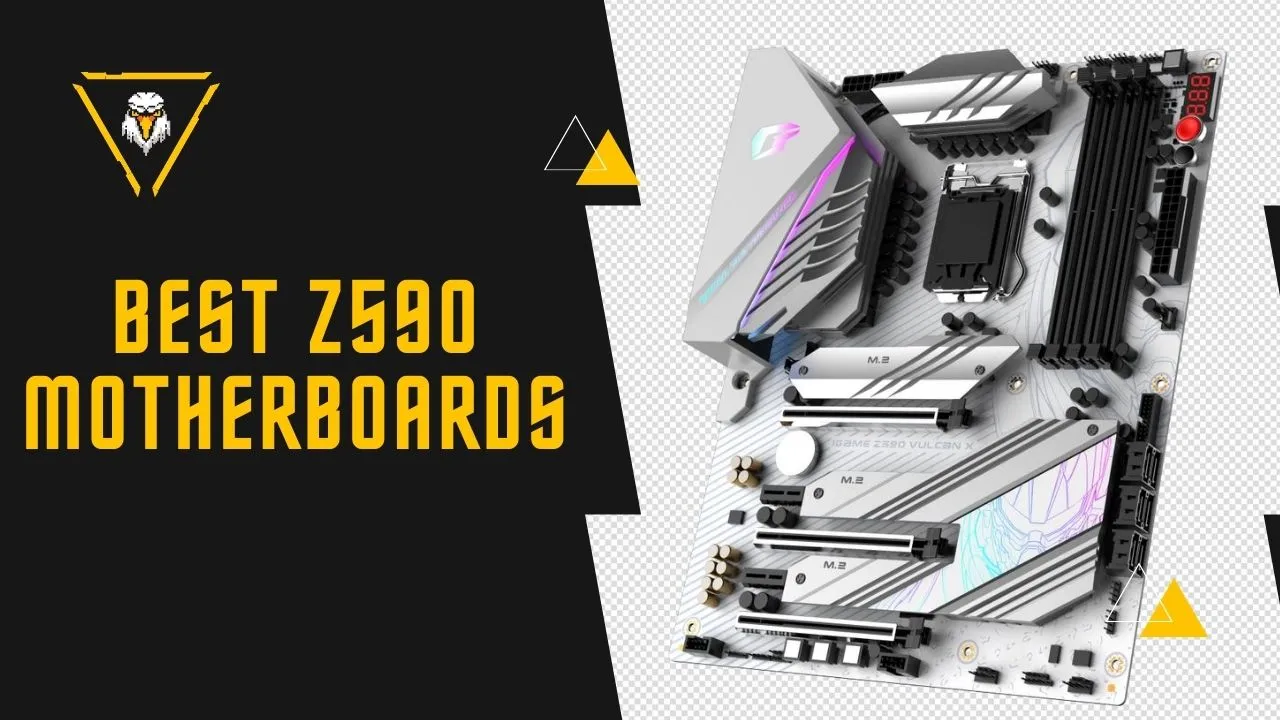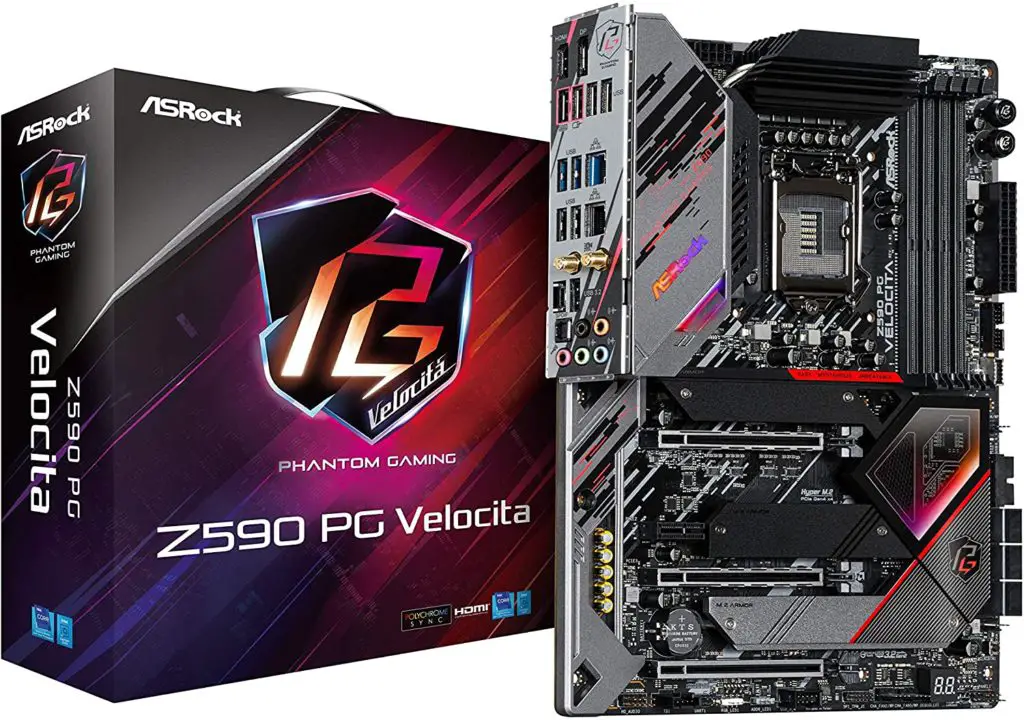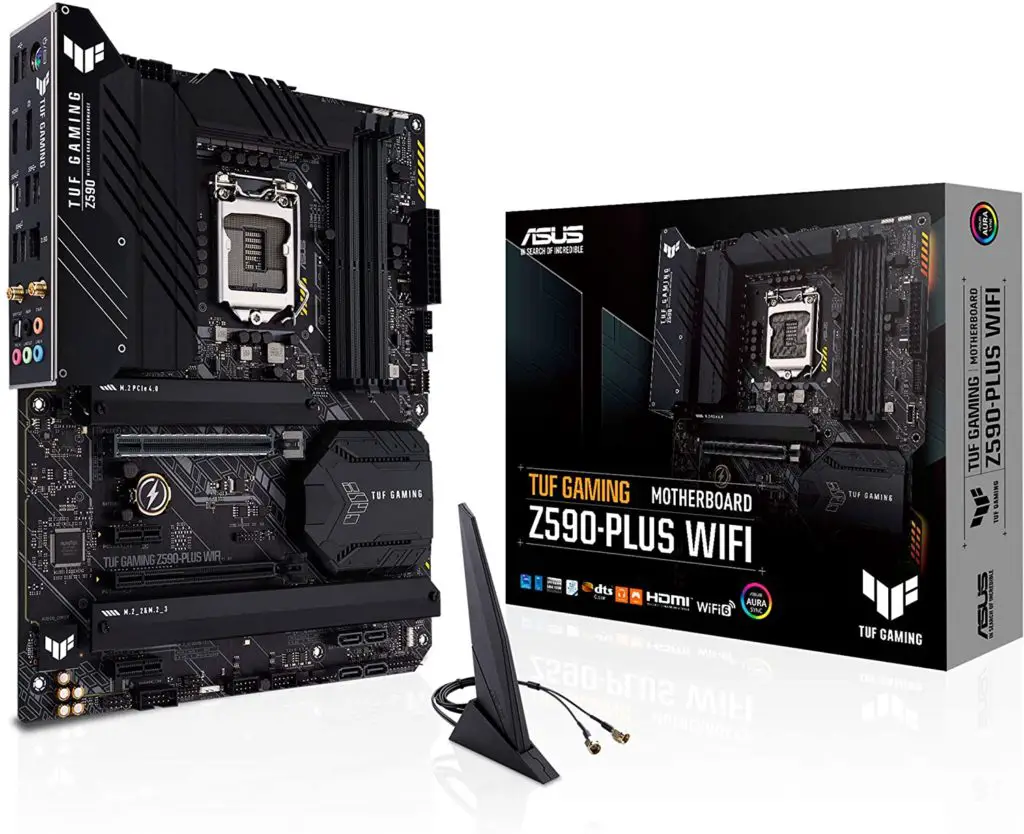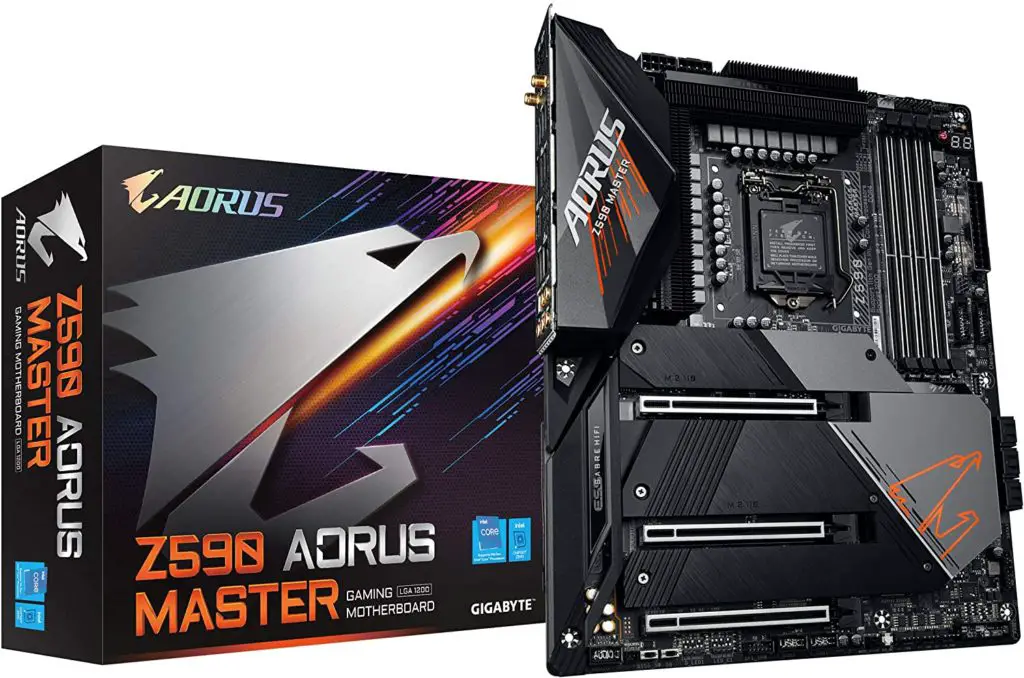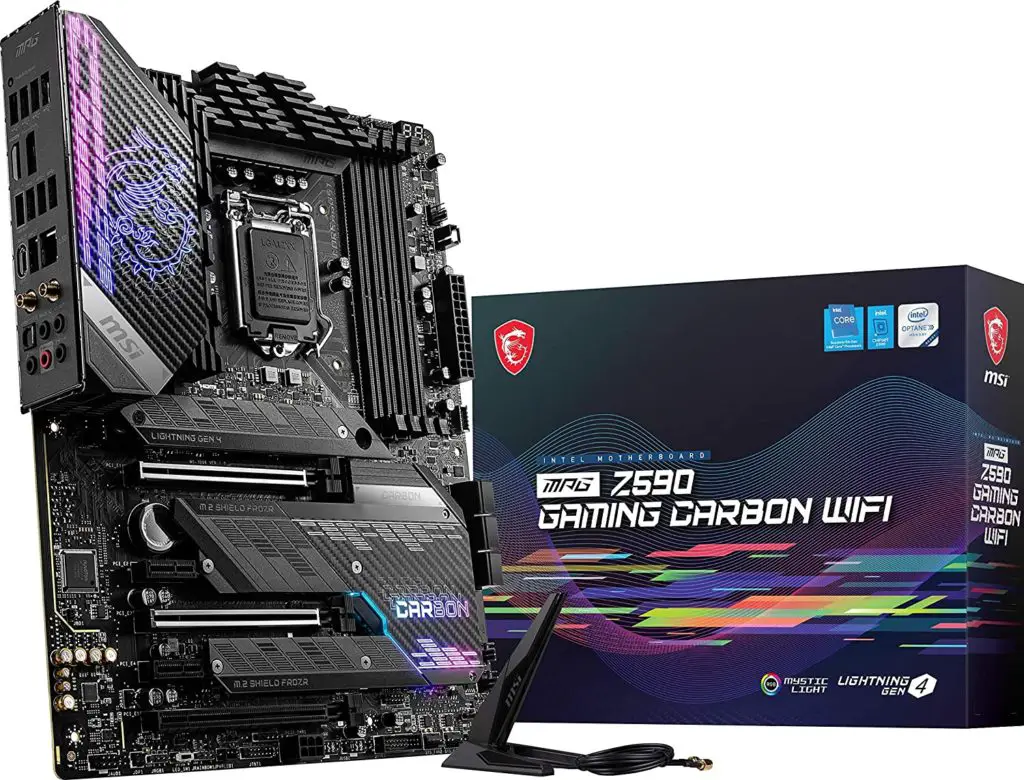The new Intel Z590 Motherboards are feature rich motherboards built for demanding CPUs. Intel’s 11th Generation of processors have landed! If you read our review of the i9-11900K in our previous issue, you’d have seen that while it performs well for the most part, it runs hot and it consumes a lot of power.
The i5-11600K and likes of the 11500 and 11400 are much more appealing and will sell well, as will Z590 motherboards. They introduce some desirable features and are built to cope with the tough demands of Rocket Lake CPUs.
Perhaps the most noteworthy inclusion is native PCIe 4.0 support – finally! This means parity with AMD and that the latest and greatest SSDs can reach their full potential. The Z590 chipset also includes a welcome doubling of the CPU-to-chipset DMI bandwidth.
This helps to alleviate any potential bottleneck that may occur if you’re running several chipset-connected devices, including M.2 drives. Most Z590 models support much faster memory, well over DDR4-5000 in some cases, thanks to the inclusion of a new memory controller divider, usually referred to as Gear 1 and Gear 2.
Premium Budget
Though of course not all boards support all features, the mid and high-end boards will include features such as WiFi 6E, native 20Gbps USB 3.2 and Thunderbolt 4. This kind of connectivity will help to keep the platform relevant for years to come. Another key characteristic is the inclusion of strong VRM circuitry, which is necessary given the peak power consumption requirements of the i7 and i9 CPUs, and particularly the latter when Adaptive Boost is enabled. CPUs that can pull 300w or more without even being considered overclocked means you need a strong foundation. Some of the cheaper Z590 boards have VRM solutions that wouldn’t have been out of place on high end boards from just a few years ago.
Given the upwards trend in motherboard pricing over the last couple of generations plus the ongoing effects of the pandemic, we had fears that we’d see another jump. Thankfully, partly due to the stronger Australian dollar and despite semiconductor supply issues, we are happy to see that pricing is better than we expected. There are many Z590 boards available for well under $300.
How we are Testing the Z590
For our testing, we ran the motherboards under both ‘light’ and ‘heavy’ loads. We’ve done this specifically to analyse how the board performs under default conditions, as well as how it handles an 11900K with Adaptive Boost enabled and the power restrictions removed. The latter is a stern test of the motherboard, and it reveals some interesting differences in peak power consumption.
Picking the winner of a motherboard roundup is usually difficult, especially in the mid-range class. A single feature here or a percentage point benchmark win there might not make a lot of difference in the grand scheme of things. Brand loyalty will likely weigh just as much on your choice of board. We think any of these boards will serve you well. So, if you’ve made the decision to grab an 11th Gen processor, you can be assured that you’ll have a solid foundation for your new system and you’ll be getting some cutting-edge I/O features. Read on as we take a look at a selection of the best mainstream Z590 motherboards!
Our Recommended list of the Best Z590 Motherboards
- Asrock Z590 PG Velocita ATX Motherboard
- Asus TUF Gaming Z590-Plus Wi-Fi
- Gigabyte Z590 Aorus Master
- MSI MPG Z590 Gaming Carbon Wi-Fi
1. Asrock Z590 PG Velocita ATX Motherboard
Say hello to the Asrock PG Velocita! It’s a new product family and an evolution of the Phantom Gaming brand. It sits in between Asrock’s mainstream ranges and the high end Taichi. Much like the MSI and Asus boards, it aims to find a balance of premium features without the top end bells and whistles that separate the sub-$500 boards from those with ever steeper price jumps. It’s a board we were excited to check out.
The Velocita features a busy looking grey, black and red theme complete with a little PCB inside the chipset heatsink. It’s a really bold design with its splashes of RGB and attention-grabbing graphics. Will it appeal to all? Maybe, maybe not, but to us it looks good. It features the usual 3x M.2 slots and six SATA ports.
We’re spending a lot of time examining the VRM designs of all the tested boards as it is central to the performance of 11th Gen CPUs, particularly the 11900K with Adaptive Boost enabled. The Velocita includes a 16-phase VRM with 60a chokes. This is more than enough current to drive an AVX loaded 11900K. The heatsinks are on the chunky side but we feel that Asrock could do a little better job with them, both in terms of surface area and their aesthetic. Under a full AB load, the VRM returned a temperature of 69 degrees, which is a good result. Although it’s one of the warmer boards, it is well within spec.
The rear I/O is a strength and an area Asrock usually equips well. About the only thing missing is a USB Gen 2×2 port though there is a header for one. Two Gen 2 ports are joined by six Gen 1 ports and two 2.0 ports. Networking duties are handled by Killer controllers, the only board in the roundup to come with them. Note that big blue Intel now owns Rivet networks, so these can be considered Intel controllers. Killer E3100G 2.5G and Intel I219V controllers are joined by a Killer AX1675X Wi-Fi 6 E controller. It’s the only board in the roundup to include dual LAN.
The Velocita performed as expected across our benchmark suite, and proved to be quite strong under lightly threaded and gaming loads. We believe Asrock tends to be aggressive with its secondary and tertiary memory as the bandwidth-sensitive 7zip benchmark shows the Asrock performing particularly well. We saw a lot of variation in the PCIe 4.0 SSD test, where the Asrock clearly has a bit of BIOS tweaking to do to catch up, though in real world ‘feel’ this won’t be noticeable.
The Velocita is very competitive in its price range, Throw in dual LAN and a couple of nice additions such as a GPU retention bracket and USB PCIe bracket too. We like its design and connectivity features. Asrock usually finds a way to add superior features and specifications without charging exorbitant prices. We do feel the Velocita is a BIOS update or two away from reaching a state of maturity. That’s just a matter of a little tuning. If you’ve got $500 to spend, the Asrock Z590 PG Velocita is a lot of board for the price.
At under $500 the Asrock competes well against boards costing more.
2. Asus TUF Gaming Z590-Plus Wi-Fi
The Asus TUF Gaming Z590-Plus Wi-Fi is Asus’ entry-level gaming board. It slots in below the high-end ROG and mid-level Strix series. The focus of TUF products has shifted away from the earliest military-themed Sabretooth branded boards complete with extended warranties to a more budget gaming tier today. Though the reliability aspect remains, it seems to be more of an aesthetic these days. The TUF Gaming Plus is positioned as a simplified and affordable option for a mainstream gamer.
The TUF Z590 Plus features a fairly simplistic design with minimal RGB and the trademark TUF splash of yellow. You get three M.2 slots, with the topmost one supporting PCIe 4.0. There are six SATA ports. Four of them are vertically oriented which may not appeal to all. There are no real surprises with the layout and the white fonts add a small touch of class to the overall look.
The TUF Gaming has a decent but not spectacular 14+2 phase DrMOS power delivery system. There are 4- and 8-pin power connectors plus heatsinks that perform well. A stress test returned a VRM temperature of just 60 degrees which surprised us. We expected higher. This is probably due to the fact that the Asus was quite power thrifty, returning the lowest power consumption reading under both default and Adaptive Boost loads. So, while the VRM is perfectly adequate, it’s not a board you’d really want to smash out hour after hour of AVX512 rendering.this board is compatible with i9-11900K and MSI MAG B560 Tomahawk.
The rear I/O is on the basic side. We are happy to see a USB Type-C 2×2 port, otherwise there are no surprises. You also get two USB 3.2 Gen2, two 3.1 Genl and two 2.0 ports. Seven USB ports in this day and age is the bare minimum, though in fairness you can add more via case headers. Wi-Fi 6 (not 6E) and 2.5G Ethernet will be adequate for a typical gaming system. A budget Realtek S1200A codec takes care of the audio duties. You also get DP and HDMI ports. It’s better to have them as an option rather than not to.
Performance can be tricky to analyse on boards that can play fast and loose with power management. Tiny margins don’t matter a lot at the best of times but it’s important to remember that the Asus consumed some 30w less than the other boards with AB on. We’re happy to give away a percent or two here or there for the sake of a significant power consumption reduction. Asus likely tunes its BIOS in order to protect its VRM from too much punishment. After all, this is a reliability themed board.
For under $379 The Asus TUF comes in towards the mid-lower end of the Z590 range. If you went for a true entry level Z590 board, we probably wouldn’t feel comfortable pushing an 11900Kwith it. The Asus can and that adds a great deal of peace of mind. What does a gamer, as opposed to a PC enthusiast, really need? It’s got Wi-Fi 6, 2.5G LAN and support for the fastest PCIe 4.0 SSDs. Setting it and forgetting it, out of sight and mind is how a lot of users run their system. And that will suit this board. It’s got the essentials, good bang for buck and it should be a safe and reliable option.
The Asus Z590 TUF is a good no frills, affordable Z590 option.
3. Gigabyte Z590 Aorus Master
Gigabyte’s Aorus Master boards usually impress us. They’re unmistakably high-end boards, but they sit in a price range that hits a good balance of pricing and premium features without resorting the extreme cost that burdens boards that include the kitchen sink.
If you’re planning to run an overclocked 11900K, you need a board with a very strong VRM, and the Aorus delivers. With its 18 phase 90A design fed by dual 8-pin power connectors, it’s about as good as it gets. We love the Aorus-finned heat sink design that prioritises function over form. The solid metal chunks on many boards may look good, but efficient cooling relies on surface area and with the way Rocket Lake can punish the VRM, Gigabyte’s choice is the smart one. With Adaptive Boost on, the highest VRM temperature we saw was just 58 degrees, that’s the best result of the test.
The board features a subtle design. Where once Aorus turned the RGB up to 11, the Z590 Master features just a couple of touches of RGB around the chipset heatsink and rear I/O. You get three M.2 slots all with heatsinks plus the now common six SATA ports. The board includes three PCIe 16x slots, but somewhat unusually, no lx slots. This shouldn’t affect a lot of users but after you use the topmost one for a GPU, you’re down to two slots, so take note if you use several expansion cards.
The Master’s rear I/O includes almost everything you’d ever want with ten USB ports including a USB 3.2 Gen 2×2 Type- C port. Would a couple more be nice at this price point? That’s a real nitpick. You get Wi-Fi 6E and – somewhat surprisingly at this price – Aquantia 10Gb LAN. Usually that’s one of those features that’s exclusive to the uber expensive flagship boards. Users of SSD-based NAS rejoice!
Motherboard audio is sometimes neglected. Not so in the case of the Z590 Aorus Master. It features the Realtek ALC1220-VB code with an ESS ES9118 Sabre DAC with WIMA and Nichicon capacitors. You’ll have to drop more than a few dollars to get a better audio solution.
Our 11900K sample is genuinely cooling-limited and 5.2GHz is the best we’ve been able to get out of it even with reproduced this result with DDR4-3600 at C14 with the memory running in 1:1 mode. Performance wise the boards are all mostly within a fraction of each other, however the Gigabyte really impressed us with its SSD performance, easily leading the other boards. In fact, it’s the first board that beat our AMD system’s results with a fast Samsung 980 Pro. Gigabyte clearly spent time getting its PCIe 4.0 performance up to scratch.
We really like the Z590 Aorus Master. It’s got a mega VRM, 10G Lan and Wi-Fi 6E and good connectivity. Add to that class leading SSD performance and a decent price and it deserves a spot on your shortlist of upper mid-range contenders. We’d like to see a PCIe lx slot or two but at this price we can hardly complain. The likes of the Asrock Taichi, MSI Ace and Asus Hero have a difficult time matching the value on offer from the Z590 Aorus Master.
If you’re planning to overclock an11900K and want a feature loaded board at a decent price, look right here.
You May Also Like These:
GIGABYTE Z590 Vision G Review – ATX Z590 Motherboard
4. MSI MPG Z590 Gaming Carbon Wi-Fi
The MSI MPG Gaming Carbon sits right in the middle of its Z590 product stack, below the expensive flagship MEG boards and above the affordable MAG range. Its upper mid-range positioning aims to strike a nice balance of affordability while including the important features that a typical gamer really needs.
The Gaming Carbon reminds us of an 80s boombox with its spectrum analyser theme. It’s a bit of a take it or leave it kind of design. We like the way that MSI has incorporated the design into the heatsink assembly, which has the dual benefit of adding surface area, which is needed for a hungrier 11th Gen CPU like the 11900K.
Storage functionality is atypical for a Z590 board with three M.2 slots, the topmost of which runs at PCIe 4.0. They are joined by six SATA ports.
A real strength of the Z590 Gaming Carbon is its 16-phase VRM with 75a power stages. It can’t quite match the VRM of the Aorus Master but an overclocked 11900K will run into cooling limitations before the board itself is stressed. It’s a bit sad that boards need power delivery systems like the ones we’re seeing on Z590 boards. Efficiency is not Rocket Lake’s strong point to put it mildly.
The rear I/O is very impressive. You get a total of ten USB ports consisting of a Type-C USB 3.2 Gen2x2 port, three USB 3.2 Gen 2 ports, two USB 3.2 Gen 1 ports and four USB 2.0 ports. The new Realtek ALC 4080 codec powers the standard set of audio ports, which includes S/PDIF. The MSI ticks the right boxes with regards to it’s networking, thanks to Intel 1225-V 2.5 GbE and AX210 Wi-Fi 6E controllers. DP and HDMI ports are useful should you need to use the Xe graphics on a Rocket Lake CPU.
The performance of the MSI was interesting. It proved to be very strong at multi-threading but it pays a price to do it. The MSI was the most power-hungry of the boards; in fact it can consume over 300w under an adaptive boost AVX load. If you plan to run this board, you’ll need to make sure you have top shelf cooling unless you hop into the BIOS to moderate the power settings. These settings are easy to find thanks to MSI’s long-running and mature BIOS design.
The MSI, with its strong VRM and heatsink assembly, didn’t break a sweat under a heavy Adaptive Boost load. Although it was one of the warmer boards we’ve tested, at 69c the temperatures aren’t a cause for any concern. Unless you win the silicon lottery, at 5.2GHz with all cores loaded the power consumption can jump to over 350w! Yes you read it right. The MSI handled it with ease.
The MSI Z590 Gaming Carbon really appeals thanks to its balance of relative affordability and quality features, particularly its strong VRM, networking and I/O. It’s at the right spot on the price/ features curve. If you added 10G LAN, a Thunderbolt controller and a water block it would be double the price. The MSI hits just the right balance.
The MSI strikes a good balance of affordability and features by omitting bells and whistles to keep the cost down.
Test Setup
- CPU: Intel Core i9-11900K
- GPU: MSI RTX 3080 Gaming X Trio
- RAM: 16GB Teamgroup T-Force DDR4-3600 14-15-15-35
- Storage: 2TB Adata S70 6500GB Samsung 980 Pro
- Case: Thermaltake Core P8
- Cooling: Nzxt X73 360mm AIO
- Power Supply: Corsair AX1000
- Operating system: Windows 10 Pro x64 20H2
* Default settings **Adaptive Boost enabled, power restrictions removed
Also, See:
- Best Motherboard for AMD Ryzen 3 5300G
- Best Motherboard for AMD Ryzen 5 5600G
- Best Motherboard For AMD RX 6400
- Best Motherboard For Radeon RX 6500 XT
Also, See: Best Z590 Motherboards – Best Motherboard for Deep Learning
